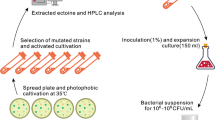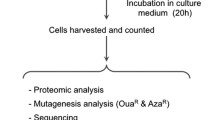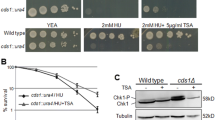Abstract
The possibility was examined that mutational events can be delayed for more than one or two cell divisions following treatment of Chinese hamster cells with the DNA alkylating agent ethyl methane sulfonate. If mutations in mammalian cells are delayed, the proportion of mutant cells in colonies grown from single mutagen-treated cells will reflect the cell division at which the mutation is genetically fixed, i.e., a first division mutation yields a 1/2 mutant colony, a fifth division mutation produces a 1/32 mutant colony, etc. In the present study, replating of cells from single colonies grown for six to seven days after mutagen treatment resulted in the discrete ratios of glucose-6-phosphate dehydrogenase (G6PD)-deficient mutant to wild-type colonies expected for a delayed mutational process which produces mutations over at least 8–10 cell generations. Further, when cells from 7- to 10-day colonies, grown from ethyl methane sulfonate (EMS)-treated cells were replated into selective medium containing 6-thioguanine (6TG), the number of 6TG-resistant colonies obtained per flask was distributed over a very wide range, consistent with a mutational delay process. These results could not be explained by differences in the number of cells per colony or plating efficiency in selective medium. Assuming that the relative number of 6TG-resistant colonies per flask reflects the time of mutation, EMS treatment produced two groups of mutational events: one which occurred within the first five cell generations and another uniformly distributed over at least the next eight to nine divisions. These results support the conclusion that EMS induces mutants for at least 10–14 cell generations after treatment and raise the possibility that current methods to assess the mutagenic potential of an agent might lead to significant underestimation. The role of delayed mutation in the phenomenon of “mutation expression time” is also discussed.
Similar content being viewed by others
Explore related subjects
Discover the latest articles and news from researchers in related subjects, suggested using machine learning.Literature cited
Witkin, E.M. (1976).Bacteriol. Rev. 40:869–907.
Witkin, E.M. (1975).Mol. Gen. Genet. 142:87–103.
Kimball, R.F. (1978).Mutat. Res. 55:85–120.
Schendel, P.F. (1981).Crit. Rev. Toxicol. 9:311–362.
Schendel, P.F., and Michaeli, I. (1984).Mutat. Res. 125:1–14.
Fox, M. (1983).Cancer Biol. Rev. 3:23–61.
Stamato, T.D., Mackanzie, L., Pagani, J.M., and Weinstein, R. (1982).Somat. Cell Genet. 8:643–651.
Stamato, T.D., Weinstein, R., and Giaccia, A. (1984).Somat. Cell Mol. Genet. 10:429–434.
Terashima, T., and Tolmach, L.J. (1963).Exp. Cell Res. 30:344–362.
Rosenstraus, M., and Chasin, L.A. (1975).Proc. Natl. Acad. Sci. U.S.A. 72:493–497.
O'Neill, P., Couch, D.B., Machanoff, R., San Sebastian, J.R., Brimer, P.A., and Hsie, A.W. (1977).Mutat. Res. 45:103–109.
Singer, B. (1979).J. Natl. Cancer Inst. 62:1329–1339.
Warren, W., Crathorn, A.R., and Shooter, K.V. (1979).Biochem. Biophys. Acta 563:82–88.
Lawley, P.D. (1976).Am. Chem. Soc. Monogr. 173:83–244.
Roberts, J.J. (1978).Adv. Radiat. Chem. 7:211–436.
Goth-Goldstein, R. (1980).Cancer Res. 40:2623–2624.
Durrant, L.G., Margison, G.P., and Boyle, J.M. (1981).Carcinogenesis 2:55–60.
Wild, C.P., Smart, G., Saffhill, R., and Boyle, J.M. (1983).Carcinogenesis 4:1605–1609.
Day, R.S. III, Ziolkowski, C.H.J., Scudiero, D.A., Meyer, S.A., Lubiniecki, A.S., Girardi, A.J., Galloway, S.M., and Bynum, G.D. (1980).Nature 288:724–727.
Author information
Authors and Affiliations
Rights and permissions
About this article
Cite this article
Stamato, T., Weinstein, R., Peters, B. et al. Delayed mutation in Chinese hamster cells. Somat Cell Mol Genet 13, 57–65 (1987). https://doi.org/10.1007/BF02422299
Received:
Revised:
Issue Date:
DOI: https://doi.org/10.1007/BF02422299




